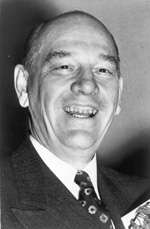Ernest Lundeen
Ernest Lundeen (August 4, 1878 – August 31, 1940) was an American lawyer and politician.
Ernest Lundeen | |
|---|---|
 | |
| United States Senator from Minnesota | |
| In office January 3, 1937 – August 31, 1940 | |
| Preceded by | Guy V. Howard |
| Succeeded by | Joseph H. Ball |
| Member of the U.S. House of Representatives from Minnesota's 5th district | |
| In office March 4, 1917 – March 3, 1919 | |
| Preceded by | George Ross Smith |
| Succeeded by | Walter Newton |
| Member of the U.S. House of Representatives
from Minnesota General Ticket Seat Eight | |
| In office March 4, 1933 – January 3, 1935 | |
| Preceded by | General Ticket Adopted |
| Succeeded by | General Ticket Abolished |
| Member of the U.S. House of Representatives from Minnesota's 3rd district | |
| In office January 3, 1935 – January 3, 1937 | |
| Preceded by | General Ticket Abolished |
| Succeeded by | Henry Teigan |
| Member of the Minnesota House of Representatives | |
| In office 1911-1914 | |
| Personal details | |
| Born | August 4, 1878 Beresford, Dakota Territory (now South Dakota) |
| Died | August 31, 1940 (aged 62) Lovettsville, Virginia |
| Political party | Republican Minnesota Farmer-Labor Party |
| Alma mater | Carleton College University of Minnesota Law School |
| Military service | |
| Branch/service | United States Army |
| Unit | Company B-12th Minnesota Volunteer Regiment |
| Battles/wars | Spanish–American War |
Lundeen was born and raised on his father's homestead in Brooklyn Township of Lincoln County near Beresford in the Dakota Territory. His father, C. H. Lundeen, was an early pioneer who was credited with the naming of Brooklyn Township as well as with helping to establish the school and other institutions located there. Most of Ernest Lundeen's brothers and sisters died during a diphtheria epidemic during the 1880s. In 1896, Lundeen and his family moved to Harcourt, Iowa and then to Minnesota. He graduated from Carleton College in Northfield, Minnesota in 1901 and then studied law at the University of Minnesota Law School. In 1906, he was admitted to the bar.
Lundeen served in the United States Army during the Spanish–American War. He served in the Minnesota House of Representatives 1911–14.[1] He then served as a Republican from Minnesota in the United States House of Representatives, from March 4, 1917 to March 3, 1919 in the 65th congress. As representative, he was one of 50 Congressman to vote against the declaration of war against Germany on April 6, 1917.[2] He served as a Minnesota Farmer-Labor Party member in the House from March 4, 1933 to January 3, 1937 in the 73rd and 74th congresses. He was elected to the United States Senate in 1936 as a member of the Farmer-Labor Party. He served from January 3, 1937 in the 75th and 76th congresses, until his death.
He remained sympathetic to Germany. According to Alton Frye, he had close ties to George Sylvester Viereck, a leading German agent. Viereck often used Lundeen's office, and "sometimes dictated speeches for Lundeen, openly using the Senator's telephones to obtain material from Hans Thomsen at the [German] embassy."[3]
On the afternoon of August 31, 1940, Lundeen was a passenger on Flight 19 of Pennsylvania Central Airlines, flying from Washington, D.C. to Detroit. The plane, a Douglas DC-3, flew into turbulence from a thunderstorm. The plane crashed near Lovettsville, Virginia and all 25 persons on board were killed, including Senator Lundeen.[4]
See also
- List of United States Congress members who died in office (1900–49)
References
- Ernest Lundeen, Minnesota Legislative Reference Library-Minnesota Legislators Past and Present
- Current Biography 1940, p. 527
- Frye, Alton (1967). Nazi Germany and the American Hemisphere 1933-1941. New Haven, CT.: Yale University Press. p. 161.
- Planecrashinfo.com retrieved June 23, 2007
- United States Congress. "Ernest Lundeen (id: L000514)". Biographical Directory of the United States Congress.
External links

- United States Congress. "Ernest Lundeen (id: L000514)". Biographical Directory of the United States Congress.
| Party political offices | ||
|---|---|---|
| Preceded by Magnus Johnson |
Farmer–Labor nominee for Governor of Minnesota 1928 |
Succeeded by Floyd B. Olson |
| Preceded by Magnus Johnson |
Farmer–Labor nominee for U.S. Senator from Minnesota (Class 2) 1930 |
Succeeded by Floyd B. Olson |
| Preceded by Floyd B. Olson |
Farmer–Labor nominee for U.S. Senator from Minnesota (Class 2) 1936 |
Succeeded by Al Hansen |
| U.S. House of Representatives | ||
| Preceded by George Ross Smith |
U.S. Representative from Minnesota's 5th congressional district 1917–1919 |
Succeeded by Walter Newton |
| Preceded by General Ticket Adopted |
U.S. Representative from Minnesota General Ticket Eighth Seat 1933–1935 |
Succeeded by General Ticket Abolished |
| Preceded by General Ticket Abolished |
U.S. Representative from Minnesota's 3rd congressional district 1935–1937 |
Succeeded by Henry Teigan |
| U.S. Senate | ||
| Preceded by Guy V. Howard |
U.S. senator (Class 2) from Minnesota 1937–1940 Served alongside: Henrik Shipstead |
Succeeded by Joseph H. Ball |
